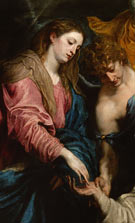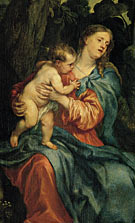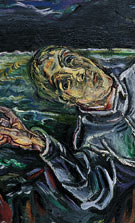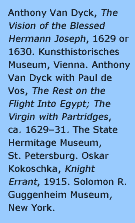 |
 |
 |
 |
|
| Connecting Museums at the State Hermitage Museum, St. Petersburg |
||
Anthony Van Dyck and Oskar Kokoschka—the seventeenth century and the twentieth century, two masters, two different worlds—are represented in this exhibit by three masterpieces from three museums: the Kunsthistorisches Museum, the Solomon R. Guggenheim Museum, and the State Hermitage Museum. Van Dyck's paintings glorify the Virgin, depicting her in one composition with her small Son (The Rest on the Flight into Egypt; The Virgin with Partridges) and in the other with a young monk, resting on one knee before Her (The Vision of the Blessed Hermann Joseph)—his pose before the Holy Virgin is similar to the medieval knight's bow to a lady. Kokoschka's painting, which the painter titled Knight Errant, depicts a lost, lone man trapped in armor and lying flat on the ground. The two Van Dyck paintings share a common history. They were painted around the same time and were intended, most likely, for the same religious institution—the Antwerp Confraternity of Bachelors, of which the painter was a member. Under the patronage of the Jesuits, the lay congregation united bachelors to support the practice of piety, good deeds, and veneration of the Madonna. All members of the confraternity gathered in their chapel for services and sermons. The chapel was on the second floor of a Jesuit monastery, located opposite a Jesuit church built in 1615–21, and dedicated to St. Ignatius Loyola (now the church of St. Charles Barromeo). The interior of the chapel was richly decorated with stained glass windows and paintings and sculptures along the walls. Gold and silver vessels added to the general impression of luxury and celebration. Many of the works of art in the chapel were created by members of the Confraternity of Bachelors. Van Dyck's contribution to the decoration of the chapel seems to have been three paintings. Two of them are part of this exhibition—from the collections of the Kunsthistorisches and the State Hermitage museums. In content, both relate to the cult of the Virgin Mary, to which the Confraternity of Bachelors in Antwerp was dedicated. The comparatively small canvas from the Kunsthistorisches museum is imbued with the sacred solemnity of the moment. For all the mysticism of its subject, there is no deliberate exaltation, typical of depictions of ecstatic visions of the saints during the Counter Reformation. The Virgin Mary appears to the pious monk during his prayer and tenderly touches with her long fingers his right hand, which a light-winged angel readily supports, acting as intermediary in this spiritual union. The touch of three hands forms the composition's semantic and psychological knot, which ties the main characters of the painting together: the beautiful and majestic Virgin and the agitated monk with a meditative and sorrowful face who gazes meekly at Her. The subtle emotions, delicate gestures, and reserved movements reveal Van Dyck's unique individual temperament, expressing his desire to create spiritually refined images, a trait that allowed the Flemish master to achieve particular spirituality in paintings with religious subjects. The graceful figures are matched by Van Dyck's exquisite painting manner and refined color scheme. The artist extracts the most tender colors from his palette, subtly combining his favorite colors of deep blue and pink, turquoise blue, and golden yellow in the clothing, while the brightness of the color chords is muted by the intricate play of chiaroscuro. For all the idealness of the images created by Van Dyck, each has an almost portrait-like concreteness. This supports the legend that the artist used members of his family as models for the painting. Thus, people saw Van Dyck's features in the intermediary angel, his sister's likeness in the Virgin, and in Hermann Joseph a semblance to the artist's younger brother, Theodore Van Dyck, who like his distant brother in the order, was a monk and, at the time of the painting, a priest at the Monastery of St. Michael in Antwerp. In any case, Van Dyck's painting The Vision of the Blessed Hermann Joseph, which was added to the chapel of the Antwerp Confraternity of Bachelors in 1630, must have appeared to its members to be a model of the chaste spiritual life bordering on the lofty world of the divine. The theme of glorification of the Holy Virgin is paramount in the other Van Dyck in this exhibit, the large multi-figured work The Rest on the Flight into Egypt, which belongs to the Hermitage. It was executed by the artist in collaboration with the famous Antwerp animalist, Paul de Voss, almost an exact peer of Van Dyck, who painted the birds in the work. Almost all the birds and plants in the composition are attributes and symbols of the Virgin Mary. Combined together, they form an extremely complex symbolic and rhetorical program that helped the artist transform the apparent subject of the painting—an episode from the childhood of Christ—into a theme related primarily to the cult of Mary, that of Mary as unsullied Virgin. However, even the formal structure of the painting is organized so that Mary's figure is perceived instantly as the semantic center of the composition. The smooth and regal turn of her body, the protectiveness with which the Holy Virgin holds the Infant on her lap, while turning a distracted look in the direction of the playing angels, set the rhythm of the entire composition, bringing into a whole its two unequal parts—the group of main characters moved to the left side of the canvas and the merry dance of little angels, who take up the clearly larger part of the painting's space. While Mary's stately silhouette in broad softly flowing robes and the figures of the mischievous cherubs are well-known reminiscences of the art of Van Dyck's particularly beloved painter Titian, the artist translates the borrowed motifs into the language of his own style. The images are distinguished by Van Dyck's peculiar restraint and grace and soft, measured movements. Even the plump and earthly angels move smoothly, taking graceful poses, as if playing in a studied performance. And still, the painting is almost completely devoid of a narrative impulse. The generally reduced rhythm of the composition endows it with the character of solemn representation typical of altar images. The solemn side of the canvas is served by the saturated color range that is set by the deep blue of the Madonna's robe, the largest color spot of the composition. In Christian art, blue is the symbol of the sky and the personification of spiritual love, fidelity, and truth. And the Virgin Mary has long been considered the incarnation of these qualities. Blue, actually the broad gradations of its tone in the range from pale blue to almost black, dominates the large painting Knight Errant by Oskar Kokoschka. The gloomy, cold colors of this work create an anxious feeling that captures the viewers' attention on first sight. Color, its saturation and expression, is the main component of the canvas's entire construction, helping us delve into the deeper layers of its content. The object is depicted rather conditionally, although the viewer can easily recognize its basic motif—the figure of a fallen and probably heavily wounded knight in medieval armor, dying on a cliff or island buffeted by a storm at sea. The conditionality of the figurative motif is seen in its deliberate deformation. It is manifested in the miscorrelation of scale between the knight's figure and the expanse of sky and landscape against which the composition unfolds. These distorted forms and the almost morbid acuteness of the artist's use of color are meant to increase the sense, created by the construction of the painting, of the loneliness of human suffering in a hostile world. And the arsenal of the painter's methods is directed not at the depiction of the suffering of human flesh, but at the expression of human feelings hidden in that mortal coil, a demonstration of the power and heights of the spiritual world. The longing of our interior life for the highest spheres of the spirit and its contiguity with the divine is one of the eternal themes of art. In the framework of this exhibition, this theme is embodied in the works—models of the baroque and of expressionism—by two dissimilar painters, each of whom had a perfect mastery of the artistic language of his time. —Natalia Gritsay |



